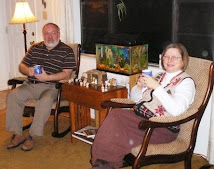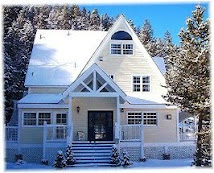 Last weekend, Kathy and I took our youngest daughter, Hannah, to Estes Park for the annual Wool Market. On exhibit were all manner of wool/fiber-producing animals. There were also workshops and demonstrations of such things as sheep shearing, spinning, and weaving. Everything was fascinating, but the highlight of the afternoon had to be the demonstration of working sheep dogs. We saw how the dogs are trained, as well as the variations in how the different breeds work the sheep.
Last weekend, Kathy and I took our youngest daughter, Hannah, to Estes Park for the annual Wool Market. On exhibit were all manner of wool/fiber-producing animals. There were also workshops and demonstrations of such things as sheep shearing, spinning, and weaving. Everything was fascinating, but the highlight of the afternoon had to be the demonstration of working sheep dogs. We saw how the dogs are trained, as well as the variations in how the different breeds work the sheep.  We saw many varieties of fiber-producing animals, including sheep and goats—and even yaks and angora rabbits. Then there were the camelids, namely the llamas, alpacas, and paco vicunas. The paco vicunas—related to the alpaca—produce very fine wool that goes for $1000 an ounce. At one time it was reserved for Inca royalty. If you'd like more information about these interesting creatures, check out this link.
We saw many varieties of fiber-producing animals, including sheep and goats—and even yaks and angora rabbits. Then there were the camelids, namely the llamas, alpacas, and paco vicunas. The paco vicunas—related to the alpaca—produce very fine wool that goes for $1000 an ounce. At one time it was reserved for Inca royalty. If you'd like more information about these interesting creatures, check out this link.
http://www.alpacaland.com/Paco-Vicuna.htm
 As you can see, the baby animals are adorable. Hannah enjoyed seeing them and petting them. Many of the llamas were shorn in ways that made them look like poodles. As the owners or handlers led the llamas into the show arena, the animals looked like overgrown poodles!
As you can see, the baby animals are adorable. Hannah enjoyed seeing them and petting them. Many of the llamas were shorn in ways that made them look like poodles. As the owners or handlers led the llamas into the show arena, the animals looked like overgrown poodles! We met a man named Switzer, who owns a paco-vicuna and alpaca farm called Switzer Land Farm (the link to his web site is the one above). Ironically (for those of you who know we are originally from Ohio), he was born in Cleveland. The logo for their farm comes from the Switzer Land Trail, a railway that was built to service the mining towns around Boulder at the turn of the 19th century. We had a nice discussion, and we each related how our families had made their way west and settled in Colorado.
We met a man named Switzer, who owns a paco-vicuna and alpaca farm called Switzer Land Farm (the link to his web site is the one above). Ironically (for those of you who know we are originally from Ohio), he was born in Cleveland. The logo for their farm comes from the Switzer Land Trail, a railway that was built to service the mining towns around Boulder at the turn of the 19th century. We had a nice discussion, and we each related how our families had made their way west and settled in Colorado.  One of the surprises at the Estes Park Wool Market was the presence of yaks. Although yak wool is not as fine as that of other wool producers, it is still quite soft and warm. There are fewer than 1,500 yaks in North America, compared to over 250,000 bison and 300,000 alpacas and llamas. For more information about yaks, check out the following web site:
One of the surprises at the Estes Park Wool Market was the presence of yaks. Although yak wool is not as fine as that of other wool producers, it is still quite soft and warm. There are fewer than 1,500 yaks in North America, compared to over 250,000 bison and 300,000 alpacas and llamas. For more information about yaks, check out the following web site: All in all, our day at the Estes Park Wool Market was both enlightening and relaxing. We hope to go again some day. For further information about the event, here's a link:
All in all, our day at the Estes Park Wool Market was both enlightening and relaxing. We hope to go again some day. For further information about the event, here's a link:


































1 comment:
Great post Dad ! Looks really interesting !! Wish we could have gone with you ! I will have to come back later (need to get dinner started now) and have a look at the links you included ...
Post a Comment